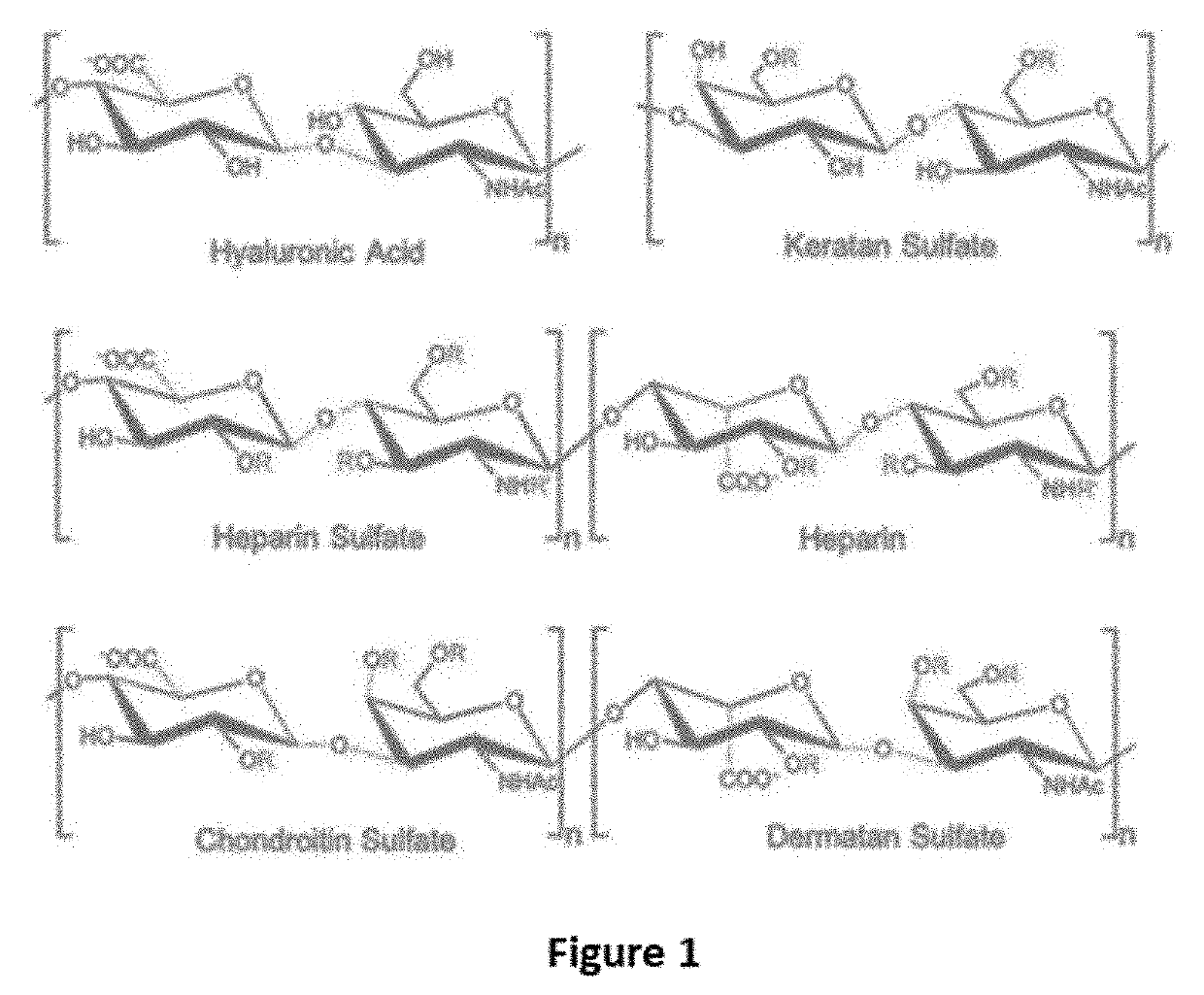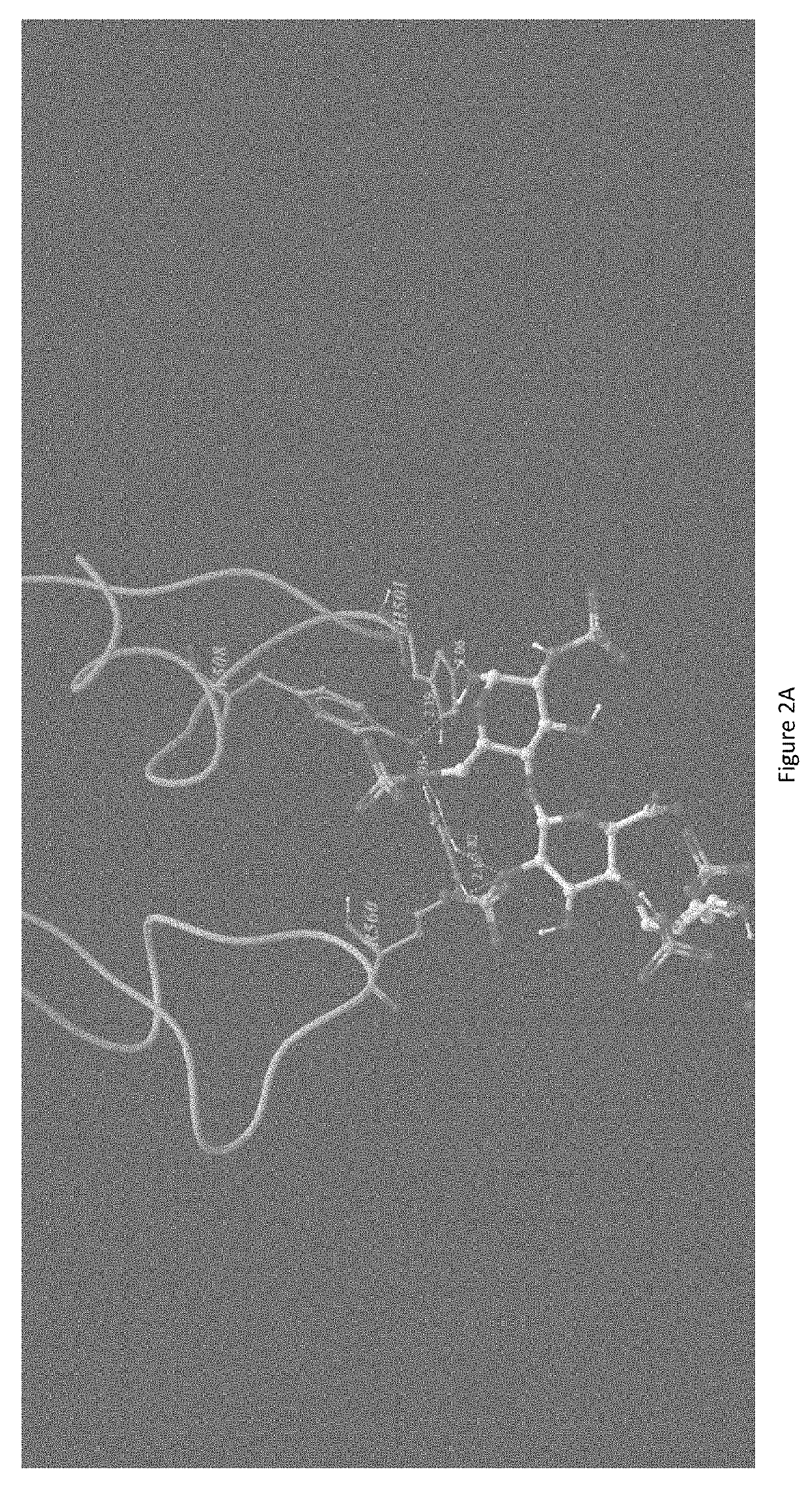Antidote for Chondroitinase
a chondroitinase and antidote technology, applied in the field of antidote for chondroitinase, can solve the problems of inactivation of chemical treatment enzymes, loss of hydration and function of discs, and spondyloepiphyseal dysplasia and premature osteoarthritis, and achieve the effect of inhibiting chondroitinase activity
- Summary
- Abstract
- Description
- Claims
- Application Information
AI Technical Summary
Benefits of technology
Problems solved by technology
Method used
Image
Examples
example 1
[0037]A Chondroitinase ABC model was generated from the crystal structure previously published (Huang W, Lunin V, Li Y, Suzuki S, Sugiura N, Miyazono H, Cygler M, Journal of Molecular Biology, (2003) 328, 623-634). A model of heparin tetrasaccharide was extracted and modified from the crystal structure of heparin (Khan, S, Gor, J, Mulloy, B, Perkins, S J, (2010) Journal of Molecular Biology 395: 504-521). The docking of the heparin tetrasaccharide to the chondroitinase ABC model was performed using Autodock v4.2. The heparin tetrasaccharide was docked within a grid box covering the whole active site with a size of 90×84×78 points using a spacing of 0.375 A. The parameters of the docking consisted of 30 Lamarckian Genetic Algorithm runs using 2,500,000 energy evaluations and a population size of 150 individuals. The docking result showed that the heparin tetrasaccharide had intensive interaction to the active residue of chondroitinase ABC, including His 501, Tyr 508, Arg 560, and His...
example 2
[0038]2 mg / ml Chondroitin sulfate C solution was prepared by dissolving in buffer at pH 8.0 Tris-HCl (50 mM). Freeze-dried chondroitinase ABC was reconstituted in 1 mg / ml BSA solution and was serially diluted to 0.5 U / ml by 1 mg / ml BSA. Both solutions were incubated at 37° C. for 5 min separately and were then mixed in a 3.5 ml quartz cuvette. The final concentration of chondroitinase ABC become 0.01 U / ml and 0.1 mg / ml chondroitin sulfate C. The reaction mixture was further incubated at 37° C. for 20 min in spectrophotometer and the absorbance at 232 nm was continuously monitored. The experiment was repeated in the presence of 0.0125 mg / ml heparin. In FIG. 3, the absorbance of the solution without the presence of heparin at 232 nm increased linearly. However, in the presence of 0.0125 mg / ml heparin, the enzymatic reaction of chondroitinase was completely inhibited.
example 3
[0039]EMSA was conducted by mixing 20 μg chondroitinase ABC (110 kDa, about 0.2 nmol) with 3.8 μg heparin (17-19kDa, about 0.2 nmol) at room temperature for 30 min. Each reaction mixture (16 μl), as well as samples with heparin and chondroitinase ABC, were mixed with 4 μl of 5× native loading buffer. The samples were loaded onto two separate 6% native gels for electrophoresis at 100V for 2.5 hours. After the electrophoresis, one gel was stained with Coomassie blue the other was stained by Alcian Blue. The gels are shown in FIG. 4 and FIG. 5. It can be seen in the gel stained with Alcian Blue (FIG. 4) that heparin is completely moved to the bottom of the gel in the absence of chondroitinase ABC. When Chondroitinase ABC is present, there is a significant amount of GAG present in the band that overlaps with the band of chondroitinase ABC. In other words, heparin is being retained by chondroitinase ABC, indicating that heparin binds tightly to the enzyme.
PUM
 Login to View More
Login to View More Abstract
Description
Claims
Application Information
 Login to View More
Login to View More - R&D
- Intellectual Property
- Life Sciences
- Materials
- Tech Scout
- Unparalleled Data Quality
- Higher Quality Content
- 60% Fewer Hallucinations
Browse by: Latest US Patents, China's latest patents, Technical Efficacy Thesaurus, Application Domain, Technology Topic, Popular Technical Reports.
© 2025 PatSnap. All rights reserved.Legal|Privacy policy|Modern Slavery Act Transparency Statement|Sitemap|About US| Contact US: help@patsnap.com



